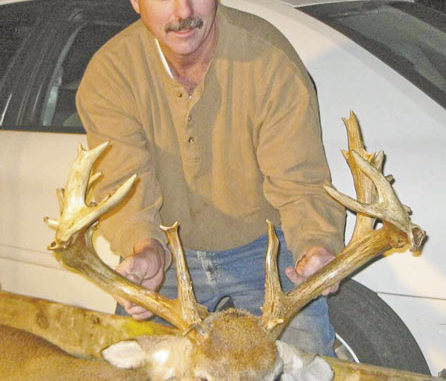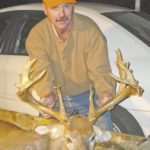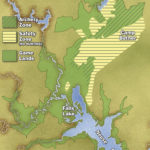
Learn from this hunter’s successful tactics to put one on your wall this season.
Ronald Briggs has seen big and small whitetail deer during his 25 years as a public-safety officer for the town of Butner.Most of them, unfortunately, weren’t killed by hunters, but by automobiles.
“I’ve investigated and seen my share of deer-car wrecks at Butner,” said Briggs, currently the town’s assistant public-safety director. “I’ve seen lots of deer in all kinds of shape — live ones, dead ones, injured ones. Seen some big bucks, too, including one great 10-pointer.”
However, Briggs was a central figure in a conventional harvest of a magnificent whitetail last year in the Rougemont community, less than 10 miles west of Butner. The antlers of Briggs’ Person County trophy eclipsed all others he’d seen hit by autos and was the top gun-season non-typical entry at the 2009 Dixie Deer Classic.
He was fortunate, too, as Briggs’ taxidermist later discovered the huge buck likely had survived a poacher’s bullet.
Briggs, 53, had prepared to shoot his 2008 buck for two years — he’d been hunting it that long.
“I’m not sure 100 percent, but I saw a buck that looked a whole lot like this buck when I was muzzle-loader hunting the same spot,” he said. “When I killed this deer, I couldn’t say it was the exact same one, but it was in the same general area. I’d seen it the previous year, too.”
Briggs said initially he wasn’t going to hunt the deer during rifle season because he wanted his 20-year-old daughter, who also is a deer hunter, to get a chance at the big boy.
“I’d been talking to my daughter, Laura, about this buck,” he said. “I sure wanted her to get a chance at him; it just didn’t work out that way.”
It dawned a perfect day for hunting whitetails on Nov. 26, 2008: clear skies, light winds, sunny and air temperature in the mid-50s.
“I really wanted to get in a stand that day for some reason, so I asked my boss, and he let me leave work a little early,” Briggs said. “It was right before Thanksgiving, and a lot of people like to be in the woods during that time.
After making the short drive home, Briggs changed into his hunting clothes. Carrying a Ruger Model 177 rifle in .308, he walked to a metal ladder stand he’d strapped to a tree; the seat was 14 feet off the ground.
“I hunt beside a ¾-acre food plot I planted in clover,” he said. “The food plot is surrounded by hardwoods and a pine thicket, and there’s a cutover nearby that’s a good bedding area for deer.”
Savvy deer hunters know whitetails crave greenery during the winter after most annuals have turned brown, so planting clover as a food plot is a common practice. Briggs also had a corn feeder at one end of the field.
He reached his stand about 3:45.
“I sat there for 45 minutes before I saw some movement in the field,” he said.
It was a button buck.
“He came out of the woods about 4:20 and started wandering around, eating clover,” Briggs said, “but I noticed he kept looking behind him into a thicket.”
Briggs raised his binoculars, adjusted the focus and peered intently at the undergrowth. He saw more movement but didn’t have a clear enough view to know if he was seeing was a buck or a doe. Then, he saw part of a buck’s rack.
“I saw enough of the rack to tell it had good mass and would be a shooter,” he said. “I put my binoculars into my coat and tried to get my scope on him.”
For tantalizing minutes, the buck refused to offer Briggs a shot, then it turned and walked directly into the clover field.
“The buck didn’t act like he was interested in the corn at all,” Briggs said. “He just started eating clover.”
Even after the buck had walked out of the thick woods only a few feet to Briggs’ left, it didn’t offer a clear shot.
“He was only 15 or 18 yards to my left,” Briggs said, “but there was a big tree between me and him. It seemed like it would take forever for (the buck) to move and give me a good shot.”
Finally the buck stepped from behind the tree, and Briggs tried to concentrate on its right shoulder. By then, he’d gotten a good look at its heavy set of antlers with all the sticker points. The sight was enough to set his heart racing.
“I put the crosshairs of my scope on his shoulder and pulled the trigger,” he said. “He ran about 30 yards and collapsed. He didn’t make it out of the field.”
Briggs had killed several other impressive whitetails, including a 13-pointer in 1992.
“I’ve also killed a number of good 8-pointers, but this one is the biggest non-typical I’ve ever killed,” he said.
The buck, which had been pursued by neighboring hunters, had 22 scoreable points.
“Once you kill (a buck) like that, people come from everywhere and tell you they’d seen it,” Briggs said. “One of my neighbors came by and asked about the deer, and I told him. He went to his truck and pulled out some trail-camera photos; it was the same buck. He’d seen it two days before about 300 yards from where I shot it. He said he was happy for me but wished he’d killed that deer.”
Briggs said everything just came together that day — no emergencies allowed him to leave work early; he walked to his stand undetected, the wind was blowing from the right direction and the big buck walked close enough to his stand he almost couldn’t miss.
“Lemme tell you, I’ve missed my share of big bucks,” he said.
The rack, a basic 4×4 mainframe, has 10 scoreable points on its left side and 12 on its right, including an exploding mass of abnormal points at the ends of both first tines, and crab-claw and points at the end of the main beams. Several 1-inch sticker points protrude from the base of the rack. The buck’s live weight totaled 185 pounds.
He discovered one oddity about his buck when he took it to taxidermist Austin Currin of Oxford: the deer had been shot at some point in the past.
“After I walked to the deer at the food plot, I noticed one of the eye pupils was white, and the buck’s ear was torn,” Briggs said. “He looked beat up; I thought he’d gotten in a fight with another buck. But when (Currin) started to work on the deer, he found a .17-caliber rifle bullet in its skull. Somebody had shot him in the eye, and the bullet had lodged in his skull.”
Small-caliber rifles are favorites of poachers, especially night hunters, because they don’t make much sound to alert landowners when someone is hunting deer illegally. And shooting a spot-lighted deer between the eyes is a poacher’s common goal — because the buck is usually dead on the spot.
Briggs said he had one regret — he wasn’t using archery equipment that day.
“This is my best buck, a great buck for me, but it’d have been nice to have a bow that day,” he said. “I really could have done some talking if I’d got this buck with a bow.”






Be the first to comment